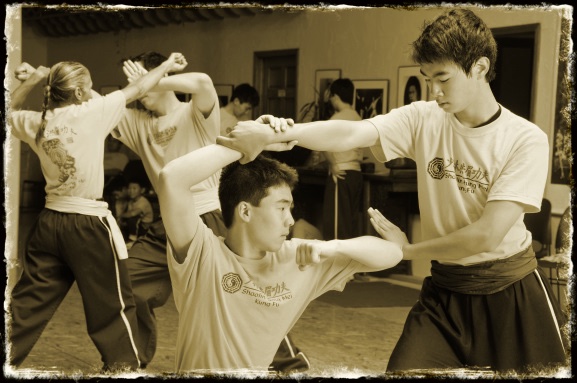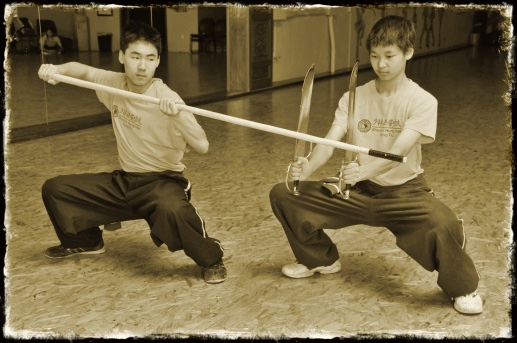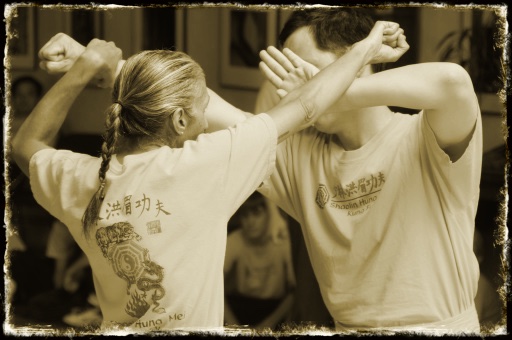
Martial Study
Two Person Training (SHUĀNG DĂ 雙打套路)
 Shaolin Hung Méi is an application-oriented style of Chinese martial arts. In order to better develop the understanding and to internalize the feeling of what each of the techniques in the various Sets is for, Hung Méi incorporates many paired exercises. Virtually every set, empty hand or weapon, has an associated paired exercise. In these exercises, one student "plays" the part of the attacker and the other performs the responsive movements from the associated set. The form is then "acted out", both students performing their techniques with full power and intensity. Even though these exercises are choreographed, the students' ability to make effective use of the movements found within the set is significantly enhanced. Both the student taking the offensive role and the other assuming the defense have the opportunity to direct their techniques against real targets; actually execute and make contact with their blocks; experience (where applicable) the subtleties of using different weapons; and
develop eye contact, timing, distancing, etc. By the time a student has learned the original set and has practiced both
sides of the related two person exercise, he or she is expected to have a firm grasp of the true application of each
and every attack and an effective counter to that attack. At that point, the student should be able to determine which
Shaolin Hung Méi is an application-oriented style of Chinese martial arts. In order to better develop the understanding and to internalize the feeling of what each of the techniques in the various Sets is for, Hung Méi incorporates many paired exercises. Virtually every set, empty hand or weapon, has an associated paired exercise. In these exercises, one student "plays" the part of the attacker and the other performs the responsive movements from the associated set. The form is then "acted out", both students performing their techniques with full power and intensity. Even though these exercises are choreographed, the students' ability to make effective use of the movements found within the set is significantly enhanced. Both the student taking the offensive role and the other assuming the defense have the opportunity to direct their techniques against real targets; actually execute and make contact with their blocks; experience (where applicable) the subtleties of using different weapons; and
develop eye contact, timing, distancing, etc. By the time a student has learned the original set and has practiced both
sides of the related two person exercise, he or she is expected to have a firm grasp of the true application of each
and every attack and an effective counter to that attack. At that point, the student should be able to determine which
 movements from the form best compliment his or her physical characteristics and mental outlook, and incorporate those
techniques into his style of defense.
movements from the form best compliment his or her physical characteristics and mental outlook, and incorporate those
techniques into his style of defense.
In addition to the Shuāng Dă (雙打) based on the empty hand and weapon sets, the Shaolin Hung Méi style includes several series of intense, paired, exercises intended exclusively for real life, defense applications. These exercises form the foundation of the defense applications of our style and their importance cannot be overstated.
 In the series called Shaolin Wŭ Háng (少林五行) — idiomatically meaning "five steps" — the student learns how to properly position his or herself with respect to the oncoming opponent. Furthermore, he or she will learn how to defend against many different attacks, respond with a counter movement directed toward a specific pressure point and subsequently knock the opponent off balance. There are 108 techniques in this series.
In the series called Shaolin Wŭ Háng (少林五行) — idiomatically meaning "five steps" — the student learns how to properly position his or herself with respect to the oncoming opponent. Furthermore, he or she will learn how to defend against many different attacks, respond with a counter movement directed toward a specific pressure point and subsequently knock the opponent off balance. There are 108 techniques in this series.
The series called Shaolin Xiăo Lín Zhuan (少林小林轉) teaches the student how to simultaneously block an incoming strike and execute an appropriate response. By performing the movements concurrently, the student will successfully land the blow as the opponent will have no time to complete a block of his own.
The series Měi Rén Quán was created generations ago by one of the women in the Hung Méi system. In it, the student trains to use of softer, deflection type methods and learns to use his or her opponent's momentum against him. These techniques depend more on speed and agility rather than strength.
There are other series of exercises, each with a distinct purpose. As indicated, these exercises form the foundation of the defense aspects of Shaolin Hung Méi. In order to be truly effective, the student must be willing to practice these techniques thousands of times. He or she must make the response to an attack totally instinctive — not requiring any thought process. It is only by doing so that the student will be able to achieve success if he or she is ever placed in an adverse situation where there is no other solution but to defend oneself.
Two-Person Exercises in Shaolin Hung Mei: 少林洪眉派雙打拳例
Shaolin Defense Techniques: 少林防身術
| Wŭ Háng | 五行 |
| Jìn Shí Quán | 近時拳 |
| Hēi Bái Zhăo Lù | 黑白找路 |
| Xiăo Lín Zhuan | 小林轉 |
| Měi Rén Quán | 美人拳 |
Băo Shŏu (Precious Hand):
| Kua Shŏu Grabs | 挎手住臂 |
| Arm Block/Backfist to the Temple | 擋臂 拳擊太陽穴 |
| Arm Deflect/Yīng Zhuă Shŏu to the Solar Plexus | 拔臂 鷹爪手 |
| Arm Deflect/ Arm Lock/Zá Shŏu to the Neck | 拔臂 住臂 砸手 |
| Zuò Mă/Fēn Shŏu/Chōng Quán to the Solar Plexus | 坐馬/分手/衝拳 |
| Kua Shŏu/Wrist Attack to the Chin | 住臂 |
Empty Hand Form Shuāng Dă: 徒手套路雙打
| Yŏng Quán Shí Zì Quán Shuāng Dă | 永泉十字拳雙打 |
| Fú Hŭ Quán Shuāng Dă | 伏虎拳雙打 |
| Hēi Hŭ Quán Shuāng Dă | 黑虎拳雙打 |
| Tai Jí Xiăo Fāng Jiā Shuāng Dă | 太極小方家雙打 |
Weapon Form Shuāng Dă: 兵器套路雙打
| Qí Méi Gùn Shuāng Dă | 齊眉棍雙打 |
| Tai Jí Qiāng Shuāng Dă | 太極槍雙打 |
| Dān Dāo Duì Qiāng Shuāng Dă | 單刀對槍雙打 |
| Shuāng Tóu Gùn Shuāng Dă | 雙頭棍雙打 |
| Kuān Dāo Duì Shuāng Dāo | 寬刀對雙刀雙打 |
| Sān Jié Gùn Duì Qiāng | 三節棍對槍 |
| Shuāng Xiăo Dāo Duì Kōng Shŏu | 雙小刀對空手 |
| Zĭ Mŭ Dāo Duì Gùn | 子母刀對棍 |
